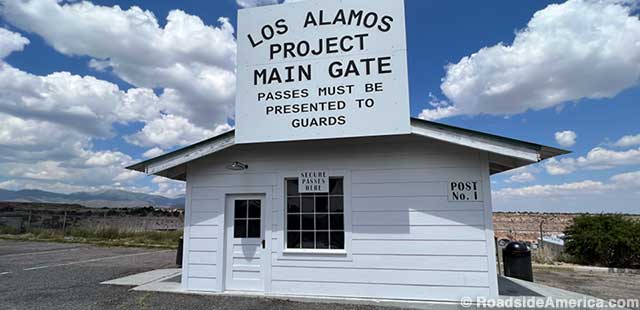
Former entry gatehouse to the top secret Los Alamos site is now a public restroom.
Los Alamos: Oppenheimer Town
Los Alamos, New Mexico
You have to drive out of your way to get to Los Alamos -- and that's no accident. Los Alamos was built in 1943 as a secret retreat where scientists could create the first atomic bomb, and sits atop an isolated mesa in northern New Mexico. Only two roads lead in and out. If tourists had tried to visit in 1943 they could have been thrown in jail, or shot.
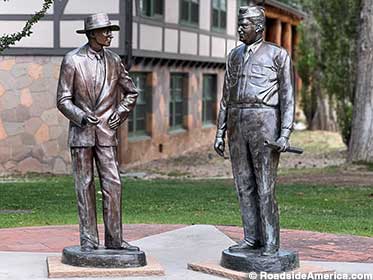
Oppenheimer and Leslie Groves: they made The Bomb possible.
It is only recently, since the release of the movie Oppenheimer in 2023, that the general public (and the IMAX-triggered) have grown interested in visiting Los Alamos. The town, now open to the world, offers a number of Atomic Age sights, most within walking distance of each other. Unlike the billion-dollar Manhattan Project that built the bomb, nearly all of the bomb attractions in Los Alamos are free.
Visitors entering from the east, as most do, encounter a replica of the old wooden Main Gatehouse, now a photo-op and public restroom, and a watchtower with gun portals across the street. Then it's a quick drive into downtown and the obvious first stop: the bronze roadside statues of J. Robert Oppenheimer, who's wearing his wide-brimmed hat, and Leslie Groves, the army general who oversaw the bomb-building effort. There's also a badly weathered wooden sign from 1964, describing Los Alamos as "The Atomic City" and "Birthplace of the Atomic Age."
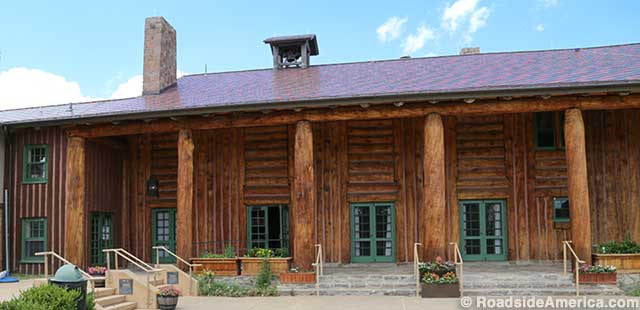
The loggy Fuller Lodge was a dining hall and motel for visiting atomic scientists.
From here some visitors walk south through a park to the Ice House Memorial, which marks the spot where the core of the first atom bomb was assembled -- and then simply driven in a car (it was a more innocent time) over 200 miles to the Trinity blast site. Most tourists, however, walk north along Bathtub Row, so named because its homes were the best in Los Alamos: the only ones with bathtubs. Oppenheimer's house is here, looking like those that were later built just to be blown up in nuclear tests.

Nuke-proof teeth, nuke-fused earth, and a cube of Nazi uranium.
Two other Bathtub Lane houses display the Atom Age artifacts of the Los Alamos History Museum. The Guest Cottage contains relics up to the end of World War II. The Bethe House continues the collection through the Cold War. The museum gift shop sells Oppenheimer bobbleheads (a perfect keepsake of a slight-of-build big-headed genius), cocktail shakers embossed with the recipe for the Oppenheimer Martini, and radiation symbol oven mitts.
Among the historic relics in the Guest Cottage: Oppenheimer's office chair, and a small chunk of Trinitite -- earth fused into a greenish glass by the nuclear fireball of the Trinity explosion. One showcase displays the aviator sunglasses of the tail-gunner aboard the Hiroshima B-29 bomber Enola Gay, along with a scorched pocket watch later recovered from the target city. Sealed in a box is a cube of Nazi uranium, reminding visitors why there was such urgency to build a bomb in the first place.
The exhibits up the street in the Bethe House are more varied. A real nuclear warhead (sans active ingredients) resembles an oversize thermos, and behaves itself quietly in a corner. It was developed at Los Alamos, as was the Cold War atom-bomb-in-a backpack, displayed half-unzippered from its carrying bag. The 1995 Nobel Prize for the detection of the neutrino (also accomplished at Los Alamos) shares space with a display of anti-nuke buttons and bumper stickers, and a world map time-lapse video of all 2,053 nuclear explosions between 1945 and 1998. It takes 14 minutes to show them all. Several were detonated at sites that tourists can still visit, such as in Parachute, Colorado, and Loving, New Mexico.
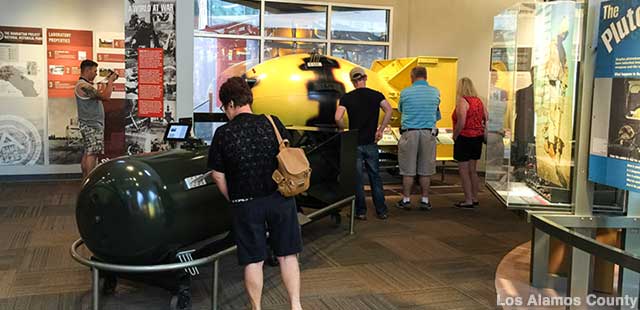
Visitors study replica historic bombs in the Bradbury Science Museum.
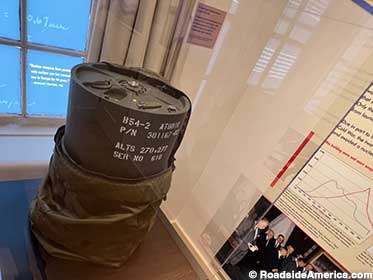
The atomic bomb backpack: invented at Los Alamos.
But it wasn't all mushroom cloud gloom and doom in the Atomic City. The Bethe House displays a pair of chic Trinitite earrings, a baseball jersey worn by a member of the Los Alamos clown baseball team, and a block of masonite on which famous scientists, such as Erico Fermi, left their bare footprints after dipping them in multicolored ink. This happened during a Los Alamos cocktail party, perhaps after one too many Oppenheimer Martinis.
Want more? Walk two blocks east on Central Avenue to the Bradbury Science Museum, named not for author Ray Bradbury but for Norris Bradbury, who oversaw Los Alamos after Oppenheimer. The displays are colorful; many are designed to be interactive. Exhibits challenge a visitor's perspective, with titles such as "Atom Bomb Saved Civilian and Military Lives" and, simply, "Explosives." Artifacts include sections of wires and vacuum tubes that were once part of the 1946 ENIAC computer, whose calculations helped to create thermonuclear weapons. There's a model of the Trinity bomb, full-size replicas of the Little Boy and Fat Man bombs -- dropped on Hiroshima and Nagasaki in 1945 -- and some modern, sleek, supersonic nukes. Ghostly white statues of Groves and Oppenheimer stand watch. Also on display is a mockup of the Slotin criticality experiment, named for Louis Slotin, the scientist who was killed by its radiation at Los Alamos.
Speaking of Slotin, one of the weirder relics on display back at the Guest Cottage are the protective gold teeth that physicist Alvin Graves had to wear after his dental fillings were accidentally irradiated during Slotin's failed experiment. And if you yearn for still more exposure, the Manhattan Project National Historical Park Visitor Center offers occasional "Behind the Fence" tours to parts of Los Alamos not normally accessible to the public, including the shed where Slotin received his lethal dose and Graves got his Atom Age teeth.





